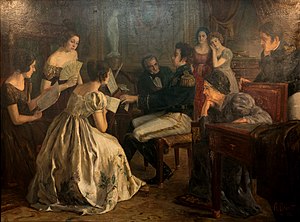Primeiros Sons do Hino da Independência
Primeiros Sons do Hino da Independência (First Sounds of the Independence Anthem), also known as Hino da Independência (Independence Anthem),[1] is a painting by Augusto Bracet made in 1922. The artwork is a historical painting, and is displayed at the National Historical Museum of Brazil. It portrays, among others, Pedro I of Brazil and Evaristo da Veiga, in 1822.[2]
| First hearing of Independence Anthem | |
|---|---|
| Primeiros Sons do Hino da Independência | |
 | |
| Artist | Augusto Bracet |
| Year | 1922 |
| Medium | oil paint, canvas |
| Dimensions | 250.00 cm (98.43 in) × 190.00 cm (74.80 in) |
| Location | National Historical Museum |
| Accession No. | 6196 |
Composition
editThe artwork was made with oil on canvas. It measures 190 centimetres (75 in) in height and 250 centimetres (98 in) in width.[2]
Description
editIt protrays the composition of the Brazilian Independence Anthem. Dom Pedro I, the composer of the music, is drawn sitting on a piano chair, apparently surrounded by people from the Court, composing the anthem.[3]
The portrayal is based on the memory of Francisco Canto de Mello. An excerpt from his writings was shown at the first public exhibit of the painting for contextualisation.[3]
Contrarily to triumphalist portrayals of Dom Pedro in the independence process, such as Independência ou Morte by Pedro Américo, the painting by Bracet explores the emperor's intimacy,[3] having him play a domestic and even feminine role.[4]
History
editThe painting was first shown publicly at the Exposition of Contemporary Art and Retrospective Art of the Independence Centenary, which began on November 12th, 1922. The painting was selected in 1923, together with artworks by Georgina de Albuquerque, Helios Seelinger and Pedro Bruno, to be bought by the state art collection.[5] The goal of this fine art event was acquiring artworks that alluded to the national [[Independence of Brazil |formation of Brazil]]. The selection was done by Flexa Ribeiro, Archimedes Memória, and Rodolfo Chambelland, with their task being searching for new iconographic portrayals of historical interpretations of independence.[3]
It is currently on display at the National Historical Museum.
References
edit- ^ "Primeiros Sons do Hino da Independência" (in Portuguese). Enciclopédia Itaú Cultural. Retrieved 9 May 2018.
- ^ a b "Museu Histórico Nacional". www.museuhistoriconacional.com.br (in Portuguese). Archived from the original on 2017-10-25. Retrieved 2018-05-09.
- ^ a b c d Vincentis, Paulo de (2014-11-06). Pintura histórica no Salão do Centenário da Independência do Brasil (Thesis) (in Portuguese). doi:10.11606/D.100.2014.tde-23012015-092503.
- ^ Cavalcanti Simioni, Ana Paula (2014-02-04). "Les portraits de l'Impératrice. Genre et politique dans la peinture d'histoire du Brésil". Nuevo Mundo Mundos Nuevos (in French). doi:10.4000/nuevomundo.66390. ISSN 1626-0252.
- ^ "BELAS ARTES. O SALÃO DE 1922. O Jornal, Rio de Janeiro, 23 nov. 1922, p. 3. - Egba". www.dezenovevinte.net (in Portuguese). Retrieved 2018-05-09.
- "Pintura histórica: Acervo MHN - Primeiros sons do Hino da Independência" (in Portuguese). National Historical Museum (Brazil). Retrieved 25 January 2020.